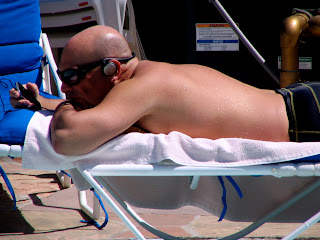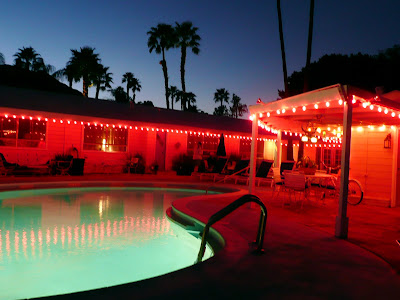
Monday, March 31, 2008
Sunday, March 30, 2008
The Odds Are Currently Taking Over At The Sands
Saturday, March 29, 2008
Friday, March 28, 2008
Thursday, March 27, 2008
Wednesday, March 26, 2008
A Surprise from Dean Crane and Kathyrn Gallagher Arrived at The Coral Sands This week.
 Ruby was thrilled this week to receive a surprise package from Sanders Dean Crane and Kathyrn Gallagher...Inside was this lone cowgirl in the buff made of pot metal and screaming for wall space outside and overlooking the fabulous kidney shaped pool. Nothing gets by her now. Thank you for your generosity, Sanders. We love our new "Sissy".
Ruby was thrilled this week to receive a surprise package from Sanders Dean Crane and Kathyrn Gallagher...Inside was this lone cowgirl in the buff made of pot metal and screaming for wall space outside and overlooking the fabulous kidney shaped pool. Nothing gets by her now. Thank you for your generosity, Sanders. We love our new "Sissy".
Tuesday, March 25, 2008
Loyal Sanders Bill and Kathy Goetz and sister Pat Patterson and her hubby Dan

This clan of Sanders have been coming since the beginning at The Sands. They are wonderful examples of the kind of people I like to think stay at The Sands. They take full advantage of the area...Casinos, Flea Markets, Thrifting, swimming, reading, drinking and just plain ole fashioned relaxing. Lola says hi, Pat...
Saturday, March 22, 2008
Art Review | 'Birth of the Cool' Store in a Cool, Fertile Place: 1950s California
 Julius Shulman’s photograph of a Case Study House designed by Pierre Koenig.
Julius Shulman’s photograph of a Case Study House designed by Pierre Koenig.Pierre Koenig Archive, Getty Research Institute
By KEN JOHNSON for the New York Times
ANDOVER, Mass. — The cool was born in New York. It was in Manhattan that Miles Davis and the nine-piece group he convened in the late 1940s forged a tightly understated alternative to the hot expressionism of bebop and recorded the hugely influential tracks later collected in the album “Birth of the Cool.” But it was in California in the 1950s that cool jazz and cool art in general took root and flourished.
The story is well told in “Birth of the Cool: California Art, Design and Culture at Midcentury,” an exhibition here at the Addison Gallery of American Art. Organized by Elizabeth Armstrong, chief curator at the Orange County Museum of Art in Newport Beach, Calif., where it originated, the show examines cool style of the ’50s in several disciplines, including painting, furniture design, architecture, film and photography.
The multidisciplinary approach could be confusing, but it all hangs together in ways both entertaining and thought provoking. What emerges is not just a style but a spirit and an ethos that are in many ways diametrically opposite those of East Coast Abstract Expressionism. Angst-free, not monumental, anti-grandiose: California cool is laid back yet cleanly articulated, impersonal yet intimate, strict yet hedonistic, and seriously playful.
Unlike many avant-garde artists of the New York school, the painters most centrally identified with the cool style in California don’t seem to have been trying to revolutionize their medium. An early label for the work of the four best-known practitioners — Karl Benjamin, Frederick Hammersley, Lorser Feitelson and John McLaughlin — was “abstract classicism,” which overstates their conservatism but highlights the formal equilibrium they sought.
Mr. Benjamin, the most appealing, worked in a lively, late Cubist style, creating compositions of flat, sharp-edged, richly colored, overlapping and interlocking shapes that are easy to imagine decorating the covers of paperback books or serving as backgrounds for movie credits. Today they look almost shockingly fresh, and so do the only slightly less vivid geometric paintings of Mr. Hammersley and Mr. Feitelson.
Mr. McLaughlin’s grid-based paintings exude a greater formal austerity. They are composed of smooth, flat rectangles of black, white, off-white and gray with blocks of color strategically inserted here and there. Inspired by Asian art and Zen Buddhism, they have a monastic air about them, but they are suave and materially sensuous too.
While paintings make the biggest visual impact in the show, the architectural photographs of Julius Shulman convey an expanded sense of the world of California cool. The exhibition presents some of Mr. Shulman’s sleek, luminous pictures of the Case Study houses, a series of midcentury works by Richard Neutra, Eero Saarinen and other architects that were meant to show the adaptability of Modernist principles to residential housing.
In Mr. Shulman’s glamorous pictures, which, unusually for architectural photography, included live models, there is a dreamy vision of the good life: a combination, one imagines, of cocktails, sex and jazz on the hi-fi. California cool looks like the product of an optimism and confidence born of post-World War II economic prosperity and seemingly unlimited room for growth.
There is a certain innocence about some aspects of California cool. The extraordinarily inventive Charles and Ray Eames went about their business of designing snazzy, unpretentious, eminently functional chairs, tables and other domestic furnishings without any of the utopian urgency to which early Modernist architects and designers were prone. In the show their short films of spinning toy tops and kaleidoscopically morphing chair fragments accompanied by jazz music appear animated by the childlike wonder they brought to every medium they explored.
A selection of Eames chairs is presented on tall shelves, calling to mind Design Within Reach, where their designs can still be purchased. This prompts thoughts about the relationship of cool design to consumerism. As Ms. Armstrong notes in her essay in the excellent catalog, one extension of the cool is the sybaritic materialism promulgated in Playboy magazine, which would come to seem increasingly uncool in succeeding decades.
Perhaps the richest manifestation of the cool was the West Coast jazz played by Gerry Mulligan (who worked with Davis on “Birth of the Cool”), Dave Brubeck, Stan Getz, Chet Baker and others. A section of the exhibition is devoted to the noirish photographs of these and other musicians by William Claxton, whose work adorned the covers of many record albums. A gripping catalog essay on Mr. Claxton’s photographs by the critic Dave Hickey taps deep into the soul of the cool.
The cool could not survive the 1960s, when all the repressed energies and conflicts of American society burst to the surface. But in its own time it was more than just a passing style. The cool did not try to change the world; rather, it was an end in itself.
It was a way of being that turned its back on the anxious striving and the inauthentic routines of corporate, middle-class life. To be cool was its own reward, a state of grace. It’s hard to imagine the stars lining up for a rebirth of the cool, but if there is a heaven, I bet it’s a pretty cool place.
“Birth of the Cool: California Art, Design and Culture at Midcentury” is at the Addison Gallery of American Art, 180 Main Street, Andover, Mass., (978) 749-4015, addisongallery.org, through April 13.
Friday, March 21, 2008
Wednesday, March 19, 2008
Monday, March 17, 2008
Sunday, March 16, 2008
Saturday, March 15, 2008
Friday, March 14, 2008
Kiki and David Lenoue have arrived at The Coral Sands...
Thursday, March 13, 2008
Wednesday, March 12, 2008
Monday, March 10, 2008
Sunday, March 9, 2008
Happy Anniversary
 On March 8, 1959, Barbie made her debut at the American Toy Fair in New York City.
On March 8, 1959, Barbie made her debut at the American Toy Fair in New York City.That's 49 years ago, fans.
In her honor, we will share some Barbie Fun Facts:
- The businesswoman Ruth Handler is regarded as the creator of Barbie, and the doll's design was inspired by a German doll called Bild Lilli.
- During a trip in 1956 with her children Barbara and Kenneth, Ruth came across a German doll called Bild Lilli. The Lilli doll was based on a popular character appearing in a comic strip drawn by Reinhard Beuthin for the newspaper Die Bild-Zeitung.
- Lilli was a working girl who knew what she wanted and was not above using men to get it. The Lilli doll was initially sold to adults.
- Mattel acquired the rights to Bild Lilli in 1964 and production of Lilli was stopped.
- Handler reworked the design of the doll (with help from engineer Jack Ryan) and the doll was given a new name, Barbie, after Handler's daughter Barbara.
- It is estimated that over a billion Barbie dolls have been sold worldwide in over 150 countries, with Mattel claiming that three Barbie dolls are sold every second.
- Barbie's full name is Barbara Millicent Roberts.
- In a series of novels published by Randon House, her parents' names are given as George and Margaret Roberts from the fictional town of Willows, Wisconsin.
- Barbie reportedly attended Willows High School and Manhattan International High School in New York City, based on Stuyvesant High School.
- She holds a pilot's license, and operates commercial airliners in addition to serving as a flight attendant.
- Careers are designed to show that women can take on a variety of roles in life, and the doll has been sold with a wide range of titles including Miss Astronaut Barbie (1965), Doctor Barbie (1988) and the infamous Nascar Barbie (1998)
- Rumors have started that Motelier Barbie is in the works for the 50th Anniversary.
Friday, March 7, 2008
Make New Friends and Keep The Old at The Coral Sands
 Kavar Kerr and Trish Ready just met at the event of the century...Karla Kellers 50th...for the first time. Kavar comes from little ole Wilson, Wyoming, while Trish hales from the Madronna area of Seattle. What a spirited occasion. Trish is a long time Sander...Kavar is a Sander virgin and may not leave.
Kavar Kerr and Trish Ready just met at the event of the century...Karla Kellers 50th...for the first time. Kavar comes from little ole Wilson, Wyoming, while Trish hales from the Madronna area of Seattle. What a spirited occasion. Trish is a long time Sander...Kavar is a Sander virgin and may not leave.














































